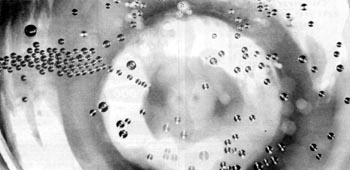Feeling Bubbly
Champagne Kisses: Local sparkling wines enliven the year's end.
Holidays lead to sparkling conversation
By Bob Johnson
IF YOU'RE PLANNING to attend a New Year's Eve party next week, chances are you'll be imbibing a bit of the bubbly. And whether it's a pricy bottle of Dom Perignon or a cheap bottle of Asti Spumante, no beverage says "party" better than champagne.
So as to avoid an international incident, let me quickly point out that the only true champagne comes from the Champagne region of France. The French are very persnickety about this point: There can be no Spanish champagne, Italian champagne, or Sonoma County champagne. They've even instigated litigation on the subject.
This is why any champagnelike bottling not from France is usually referred to by the generic term "sparkling wine."
Talking about champagne and/or sparkling wine can be almost as much fun as drinking it. And since we often find ourselves conversing with complete strangers at parties, a ready supply of sparkling conversation can come in handy. To prepare yourself for New Year's Eve, try committing the following fascinating facts to memory so that you may call upon them during those inevitable awkward and silent moments ...
NOW THAT YOU KNOW enough about champagne to be dangerous at a party, why not purchase a bottle or two? The Sonoma County sparklers that follow are rated on a scale of one to four corks: one cork, OK to drink in a traditional wine glass; two corks, Napoleonic in stature (you need it and you deserve it); three corks, the French be damned, this is great champagne; and four corks, worthy of Marie Antoinette herself.
Gloria Ferrer 1989 Brut
J. Wine Co. 1993 J Sparkling Wine
Van der Kamp 1993 English Cuvée
Geyser Peak 1993 Sparkling Red Wine
Iron Horse 1990 Blanc de Blancs LD
Domaine Carneros 1992 Brut
Schug 1995 Rouge de Noir Brut
Korbel Natural California Champagne
[ Sonoma County | MetroActive Central | Archives ]
Copyright © Metro Publishing Inc. Maintained by Boulevards New Media.
![]()

Janet Orsi
Very spritzy, with layers of ripe apple and butter flavors leading to a tart citrus finish. Well melded. 4 corks. Also from Gloria Ferrer: Sonoma Brut, 3.5 corks; and Blanc de Noirs, 3.5 corks.
A leesy, citrusy nose leads to cherry and peach flavors and a cherry/citrus finish. The stylized "J" on the bottle makes this wine a marvelous gift. 4 corks.
A big, bold style with toasty buttery qualities, a citrus fruit flavor, and a long, lingering afterflavor. 3.5 corks.
What happens when you take an Aussie's cabernet-shiraz blend and decide to do a méthode champenoise? Here is winemaker Darryl Groom's answer, and a pleasing one it is. Heady, ripe red fruit flavors are in the nose and on the palate, leading to a clean, fruity finish. This highly unusual bottling isn't for everyone, but I wouldn't mind finding it under my Christmas tree. Available only at the winery. 3.5 corks.
A very yeasty, creamy nose leads to alluring lemon oil and nutty flavors and a pleasing, lingering finish. 3.5 corks. Also from Iron Horse: 1989 Brut LD, 3.5 corks; 1992 Classic Vintage Brut, 3.5 corks; 1992 Russian Cuvée, 3.5 corks; 1991 Vrais Amis ("True Friends"), 3.5 corks; 1994 Wedding Cuvée, 3 corks; and 1991 Brut Rosé, 3 corks.
Crisp and clean with attractive banana and caramel nuances and evident toastiness. 3.5 corks.
Tasty strawberry and cherry aromas and flavors in a clean, crisp style. The Wine Spectator panned this bottling; it may not be the best sparkler to date from Schug, but it's quite tasty and refreshing. 3 corks.
A flowery nose leading to sweet citrus and green apple flavors. 3.5 corks. Also from Korbel: Kosher Champagne, 3 corks; Brut Champagne, 3 corks; 1991 Le Premier Champagne, 2.5 corks; Rouge Champagne, 2 corks; Extra Dry Champagne, 2 corks; and Chardonnay Champagne, 1.5 corks.
From the December 24-31, 1997 issue of the Sonoma County Independent.
![[MetroActive Dining]](/gifs/dining468.gif)